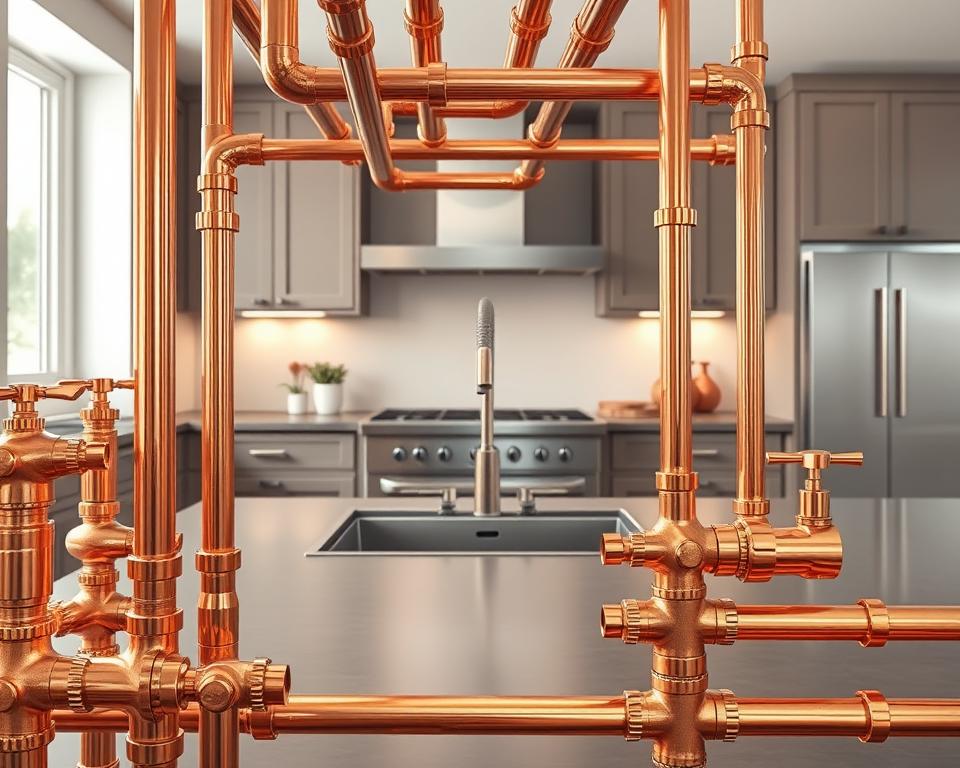Understanding Copper Pipe Sizes for Residential Water Lines
Did you realize that almost 30% of household plumbing problems are caused by pipes of the wrong size? Choosing the right dimensions ensures optimal water pressure and system efficiency. This overview assists homeowners in mastering sizing fundamentals for home plumbing.
Determining the right size relies on considerations like required flow and wall measurement. The industry standard 5/8 pipe ranges from 1/4″ to 8″ diameters, measured by NPS (Nominal Pipe Size) and actual outer dimensions. Turn to Installation Parts Supply for specialist support to pair your home’s needs with regulation-approved products.
Copper remains a top choice due to its durability and corrosion resistance. Whether retrofitting your setup or installing from scratch, knowing these principles cuts downtime and avoids costly mishaps.
Major Highlights

- Accurate sizing stops 30% of usual plumbing issues
- Diameters typically span 1/4″ to 8″
- NPS labels don’t match real outer diameters
- Proper sizing maintains water pressure and efficiency
- Copper offers durability and corrosion resistance
- Specialist support secures regulation adherence
Why Copper Pipes Are Ideal for Your Plumbing?
Long-lasting plumbing begins by choosing the proper material—copper excels for these reasons. Boasting a half-century lifespan and NSF potable-water approval, it’s a go-to for residences. It uniquely blends durability with environmental responsibility.
Toughness and Rust Protection
Thanks to its innate corrosion resistance, copper outperforms PVC/PEX. Smooth bore reduces friction, keeping water pressure steady. Field cases demonstrate leak-free decades-long service.
Installation Parts Supply stocks quality-certified options to match your project needs. Although upfront costs rise, less frequent repairs yield savings over time.
Bendability and Freeze Safety
In chilly regions, copper expands just enough when freezing to avoid splits. Such pliability cuts down the danger of expensive freeze harm. Combine with adequate insulation to optimize freeze defense.
Eco-Friendly and Antimicrobial Benefits
Copper is 100% recyclable, reducing environmental impact. Its germ-killing traits help safeguard against bacterial contamination. Environmentally minded users find it superior to plastic substitutes.
Mastering Copper Water Line Measurements and Styles
Pipe sizing can baffle homeowners—this section clarifies it. They employ Nominal Pipe Size (NPS), a label differing from true OD. For example, a 1/2″ NPS has an outer diameter of 0.625″.
Nominal vs. Actual Pipe Dimensions
NPS numbers are labels, not exact measurements. Always check the outer diameter (OD) before purchasing. Refer to this chart:
- 1/4″ NPS = 0.375″ OD
- 1/2″ NPS corresponds to 0.625″ OD
- 3/4″ nominal → 0.875″ actual
L vs. M vs. K Copper Pipes
Three copper variants lead in home plumbing. Their wall thickness determines strength and use cases:
- Type L: Thin-wall (0.040″ @ 1/2″), suited for typical dwellings.
- Type M: Mid-wall (0.050″ @ 1/2″), cost-effective yet durable.
- Type K: Heavy gauge (0.060″ @ 1/2″), ideal under high PSI.
For versatility, Installation Parts Supply favors Type M in most setups. Larger diameters (over 2″) often require Type K for irrigation or commercial use.
Type L Copper Pipes: Thin-Wall Versatility
For homeowners tackling DIY projects, L-type offers unmatched flexibility. Its thin-wall construction reduces weight and cost while maintaining reliability. Available in rigid sticks or soft coils, it adapts to everything from HVAC lines to drain systems.
Where L-Type Excels and Falls Short
It’s perfect for low-PSI situations. With 0.040″ walls, it’s great for:
- HVAC refrigerant lines
- Drain-waste-vent (DWV) systems
- Residential water supply (below 80 PSI)
Not for high PSI—opt for Type K if stress exceeds limits. Up to 50ft flexible coils hug corners, though bending must be gentle to prevent pinches.
Sizing Options and Installation Tips
Sizes span 1/4″–8″, including:
| Form | Max Length | Best For |
|---|---|---|
| Rigid | 20ft | Straight runs |
| Coiled | 50ft | Tight spaces |
Beginners will find rigid lengths, as recommended by Installation Parts Supply, the easiest to cut and solder. For large projects, coiled options reduce joint counts, saving time and potential leak points.
M-Type Copper Pipes: The Homeowner’s Choice
Balancing cost and performance, M-type emerges as the top pick for modern homes. Its medium-wall design handles everyday demands while keeping budgets in check. Approved by NSF for water and gas, it works in kitchens, baths, and heating.
M-Type Best Applications
Perfect for mixed hot/cold service, keeping water pressure uniform. Rigid 12ft sticks fit straight sections; 100ft coils flex around obstacles. Common applications include:
- Drinking water distribution
- Medical gas lines (oxygen, nitrous oxide)
- HVAC refrigerant lines
Thickness vs. Pressure for M-Type
Sits midway between L and K in gauge and strength. With 0.050″ walls, it tolerates up to 150 PSI without failure. Review these benchmarks:
| Type | Wall Thickness (1/2″) | Max Pressure | Best For |
|---|---|---|---|
| L | 0.040″ | 80 PSI | Low-pressure DWV |
| M | 0.050″ | 150 PSI | Residential supply |
| K | 0.060″ | 200 PSI | Irrigation |
Installation Parts Supply keeps M-type stocked across standard diameters. For gas lines, pair with flare fittings to prevent leaks. Leave small expansion joints in hot lines for temperature shifts.
K-Type Copper: Maximum Strength
For ultimate robustness, choose K-type in rigorous settings. Thick gauge and strong PSI rating enable industrial and subterranean applications. It withstands both compression and corrosion better than lighter gauges.
K-Type for High PSI & Irrigation
Where weaker pipes give out, K-type endures. With 0.060″ walls, it tolerates 200 PSI, suitable for:
- Underground irrigation systems
- Commercial HVAC refrigerant lines
- Fire sprinkler networks
For buried lines, Installation Parts Supply recommends 18″ minimum depth. Use compression connectors tightened to 25 ft·lb to seal joints.
Rigid vs. Coil: Installation Advice
Pick rigid or coil depending on application. Rigid 12ft sticks suit straight runs, while 50ft coils navigate obstacles. Compare performance:
| Form | Best For | Limitations |
|---|---|---|
| Rigid | High-pressure mains | Requires more fittings |
| Coiled | Trenchless installations | Risk of kinks if bent sharply |
In irrigation layouts, allow 10% for thermal growth. Rigid sections require a bending tool to prevent efficiency-sapping kinks.
Installing and Caring for Copper Pipes
Proper installation techniques ensure decades of leak-free performance in plumbing systems. Whether you’re a DIY enthusiast or hiring a pro, understanding the basics saves time and avoids headaches. Follow these methods to achieve secure, long-lasting results.
Soldering vs. Compression vs. Push-Fit
Select the joining style that fits your task. Use solder or compression for lasting joins; temporary fittings for flexibility. Compare the pros and cons:
| Method | Pros | Cons | Best For |
|---|---|---|---|
| Soldering | Strong, permanent | Requires skill | Water supply lines |
| Compression | No heat needed | Bulky fittings | Tight spaces |
| Push-Fit | Quick installation | Higher cost | Emergency repairs |
Step-by-Step Soldering Guide
For a flawless joint, follow these steps:
- Use emery cloth to clean both surfaces.
- Apply flux evenly to both pieces.
- Heat until the flux bubbles.
- Apply solder to the seam; it will wick in automatically.
Use flameproof gloves and ensure proper ventilation. Lead-free solder for potable lines is available at Installation Parts Supply.
Avoiding Drips and Freeze Breaks
Use foam insulation on pipes in cold spots. Fit foam sleeves where lines pass exterior walls. To fix minor issues:
- Inspect fittings yearly for green patina indicating leaks.
- Hang horizontal pipes at 32 inches intervals to avoid sag.
- Use frost-resistant faucets where temperatures drop.
A yearly review stops small leaks from worsening. Stash wrenches, cutters, and Teflon tape in your kit for fast repairs.
Wrapping Up: Choosing Copper Pipes
A well-planned system lasts decades—let’s wrap up with key takeaways. Pick the correct gauge and diameter to maximize durability. Don’t forget:
- Type M is best for homes; Type K for demanding uses
- Accurate dimensions keep pressure up and leaks down
- Frost defense matters where it gets cold
Installation Parts Supply offers expert guidance to simplify choices. Certified solutions with quality warranties keep your plumbing systems running perfectly.
For support, grab our free guides or arrange a consultation right away. First orders receive unique deals—kick off your job the best way!


